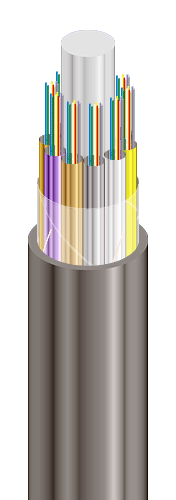ÎÀðÁãÏí * 10 – 2.7
ÒÓ Ó 31.3-00214534-036-2004 |
| Fiber optic module-core cables, aramid-yarn armoured, corrugated steel-tape armoured, with polymer compound flame-retardant outer sheath |
| Mark formation: |
| ÎÀðÁãÏí-[a]-[b] [c]10(10x[e])-2.7 |
| [a] central strength element |
| • C – steel |
| • No marks – dielectric |
| [b] quantity of optical fibers in the cable, possible values |
| • 60, 80, 100, 120, 130, 140, 150, 160 |
| [c] type of optical fiber |
| • E – single-mode (ITU-T G.652B) |
| • A – single-mode with extended wavelength band (ITU-T G.652D, ITU-T G.657A1) |
| • C – single-mode with non-zero shifted dispersion (ITU-T G.655) |
| • M – multimode with core and sheath diameter ratio 50 : 125 mm (ITU-T G.651) |
| • B – multimode with core and sheath diameter ratio 62.5 : 125 mm (IEC 60793-2) |
| [e] quantity of optical fibers in the module: |
| • 1 ... 16 |
|
|
|
| Manufacturing of cables in climate version F is possible |
| Manufacturing of cables with steel strength element is possible |
| It is possible to manufacture cables with gel-filled core or dry core (with water-blocking yarns and tapes) |
| It is possible to manufacture cables with a number of core elements up to and including 18 |
|
|
|
| Order placing: sample of indication (corresponds to configuration pattern) |
| ÎÀðÁãÏí-80A10(10x8)-2.7 • ÒÓ Ó 31.3-00214534-036-2004 |
|
|
|
| Cables are used for: |
| • laying in soils of all groups, including soils with low, medium and high corrosion activity, and in the areas contaminated by rodents, except for soils subjected to cryosolic and other distortions, as well as in cable ducts, blocks, etc. |
| • in areas with exclusive fire safety requirements |
|
|
|
| Fire safety code in accordance with ÄÑÒÓ 4809:2007: ÏÁ130122000 |
| Products of this mark meet the requirements: |
| • single wire cable flame retardance |
| • bunched cable flame retardance category B |
| • class ÄÒê1 on smoke-forming ability by smouldering of non-metallic elements (coefficient of smoke formation from 50 to 500 m2/kg) |
| • class ÄÏê2 on smoke-forming ability by combustion (minimum luminous flux more than 60 %) |
| • corrosive class Êê2 of combustion products of non-metallic elements (the number of halogen hydrides less than 150 mg/g, pH more than 4.3, specific conductivity less than 10 µS/mm) |

































